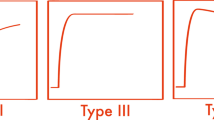Abstract
MRI has become an invaluable diagnostic tool in all areas of the body. However, it has not been widely used to image odontogenic tumors of the jaw. Major advantages of MRI include excellent soft tissue contrast in the absence of ionizing radiation. Furthermore, diffusion-weighted MRI and dynamic contrast-enhanced MRI can be used as functional imaging techniques for assessing tissue biology. In this review article, we present representative MR images of several types of odontogenic tumors, and discuss MR imaging characteristics useful for differential diagnosis.







Similar content being viewed by others
References
Han Y, Fan X, Su L, Wan Z. Diffusion-weighted MR imaging of unicystic odontogenic tumors for differentiation of unicystic ameloblastomas from keratocystic odontogenic tumors. Korean J Radiol. 2018;19:79–84.
Srinivasan K, Seith Bhalla A, Sharma R, Kumar A, Roychoudhury A, Bhutia O. Diffusion-weighted imaging in the evaluation of odontogenic cysts and tumours. Br J Radiol. 2012;85:e864–70.
Eida S, Hotokezaka Y, Katayama I, Ichikawa Y, Tashiro S, Sumi T, Sumi M, Nakamura T. Apparent diffusion coefficient-based differentiation of cystic lesions of the mandible. Oral Radiol. 2012;28:109–14.
Barnes L, Eveson JW, Reichart P, Sidransky D, editors. WHO classification: pathology and genetics of head and neck tumours. Lyon: IARC; 2005.
El-Naggar AK, Chan JKC, Grandis JR, Takata T, Slootweg PJ, editors. WHO classification of head and neck tumours. 4th ed. Lyon: IARC; 2017.
Abdel Razek AAK. Odontogenic tumors: imaging-based review of the fourth edition of World Health Organization classification. J Comput Assist Tomogr. 2019;43:671–8.
Apajalahti S, Kelppe J, Kontio R, Hagström J. Imaging characteristics of ameloblastomas and diagnostic value of computed tomography and magnetic resonance imaging in a series of 26 patients. Oral Surg Oral Med Oral Pathol Oral Radiol. 2015;120:e118–30.
Konouchi H, Asaumi J, Yanagi Y, Hisatomi M, Kawai N, Matsuzaki H, Kishi K. Usefulness of contrast enhanced-MRI in the diagnosis of unicystic ameloblastoma. Oral Oncol. 2006;42:481–6.
Baba A, Ojiri H, Minami M, Hiyama T, Matsuki M, Goto TK, Tatsuno S, Hashimoto K, Okuyama Y, Ogino N, Yamauchi H, Mogami T. Desmoplastic ameloblastoma of the jaw: CT and MR imaging findings. Oral Radiol. 2020;36:100–6.
Harmon M, Arrigan M, Toner M, O’Keeffe SA. A radiological approach to benign and malignant lesions of the mandible. Clin Radiol. 2015;70:335–50.
Probst FA, Probst M, Pautke Ch, Kaltsi E, Otto S, Schiel S, Troeltzsch M, Ehrenfeld M, Cornelius CP, Müller-Lisse UG. Magnetic resonance imaging: a useful tool to distinguish between keratocystic odontogenic tumours and odontogenic cysts. Br J Oral Maxillofac Surg. 2015;53:217–22.
Hara M, Matsuzaki H, Katase N, Yanagi Y, Unetsubo T, Asaumi J, Nagatsuka H. Central odontogenic fibroma of the jawbone: 2 case reports describing its imaging features and an analysis of its DCE-MRI findings. Oral Surg Oral Med Oral Pathol Oral Radiol. 2012;113:e51–8.
Asaumi J, Matsuzaki H, Hisatomi M, Konouchi H, Shigehara H, Kishi K. Application of dynamic MRI to differentiating odontogenic myxomas from ameloblastomas. Eur J Radiol. 2002;43:37–41.
Lam EWN. Part III Interpretation: malignant neoplasms. In: Mallya SM, Lam EWN, editors. White and Pharoah’s oral radiology. 8th ed. St. Louis: Elsevier; 2019. p. 493–518.
Willinek WA, Schild HH. Clinical advantages of 3.0 T MRI over 1.5 T. Eur J Radiol. 2008;65:2–14.
Suzuki N, Kuribayashi A, Sakamoto K, Sakamoto J, Nakamura S, Watanabe H, Harada H, Kurabayashi T. Diagnostic abilities of 3T MRI for assessing mandibular invasion of squamous cell carcinoma in the oral cavity: comparison with 64-row multidetector CT. Dentomaxillofac Radiol. 2019;48:20180311.
Song YS, Lee IS, Choi KU, Cho KH, Lee SM, Lee YH, Kim JI. Soft tissue masses showing low signal intensity on T2-weighted images: correlation with pathologic findings. J Korean Soc Magn Reson Med. 2014;18:279–89.
Jee WH, Choe BY, Kang HS, Suh KJ, Suh JS, Ryu KN, Lee YS, Ok IY, Kim JM, Choi KH, Shinn KS. Nonossifying fibroma: characteristics at MR imaging with pathologic correlation. Radiology. 1998;209:197–202.
Swartz JE, Driessen JP, van Kempen PMW, de Bree R, Janssen LM, Pameijer FA, Terhaard CHJ, Philippens MEP, Willems S. Influence of tumor and microenvironment characteristics on diffusion-weighted imaging in oropharyngeal carcinoma: a pilot study. Oral Oncol. 2018;77:9–15.
van Rijswijk CS, Geirnaerdt MJ, Hogendoorn PC, Taminiau AH, van Coevorden F, Zwinderman AH, Pope TL, Bloem JL. Soft-tissue tumors: value of static and dynamic gadopentetate dimeglumine-enhanced MR imaging in prediction of malignancy. Radiology. 2004;233:493–502.
Lam PD, Kuribayashi A, Imaizumi A, Sakamoto J, Sumi Y, Yoshino N, Kurabayashi T. Differentiating benign and malignant salivary gland tumors: diagnostic criteria and the accuracy of dynamic contrast-enhanced MRI with high temporal resolution. Br J Radiol. 2015;88:20140685.
Assili S, Kazerooni AF, Aghaghazvini L, Rad HRS, Islamian JP. Dynamic contrast magnetic resonance imaging (DCE-MRI) and diffusion weighted MR imaging (DWI) for differentiation between benign and malignant salivary gland tumors. J Biomed Phys Eng. 2015;5:157–68.
Park M, Kim J, Choi YS, Lee SK, Koh YW, Kim SH, Choi EC. Application of dynamic contrast-enhanced MRI parameters for differentiating squamous cell carcinoma and malignant lymphoma of the oropharynx. AJR Am J Roentgenol. 2016;206:401–7.
Asaumi J, Yanagi Y, Konouchi H, Hisatomi M, Matsuzaki H, Kishi K. Application of dynamic contrast-enhanced MRI to differentiate malignant lymphoma from squamous cell carcinoma in the head and neck. Oral Oncol. 2004;40:579–84.
Acknowledgements
We thank Helen Jeays, BDSc AE, from Edanz Group (https://en-author-services.edanzgroup.com/ac) for editing a draft of this manuscript.
Author information
Authors and Affiliations
Corresponding author
Ethics declarations
Conflict of interest
The authors declare that they have no conflict of interest.
Additional information
Publisher's Note
Springer Nature remains neutral with regard to jurisdictional claims in published maps and institutional affiliations.
Rights and permissions
About this article
Cite this article
Kurabayashi, T., Ohbayashi, N., Sakamoto, J. et al. Usefulness of MR imaging for odontogenic tumors. Odontology 109, 1–10 (2021). https://doi.org/10.1007/s10266-020-00559-z
Received:
Accepted:
Published:
Issue Date:
DOI: https://doi.org/10.1007/s10266-020-00559-z




